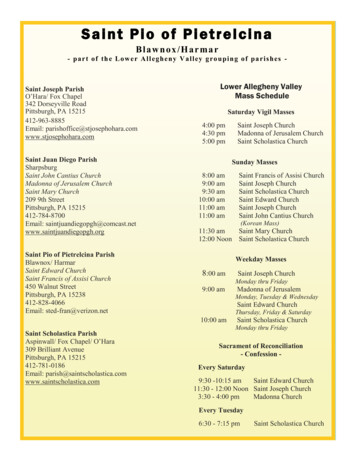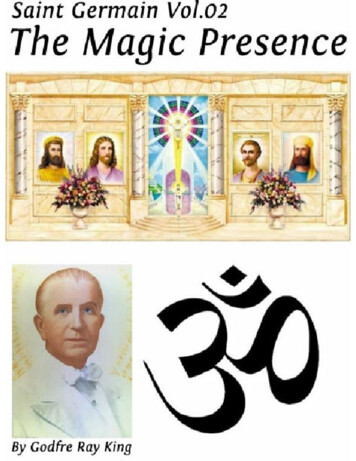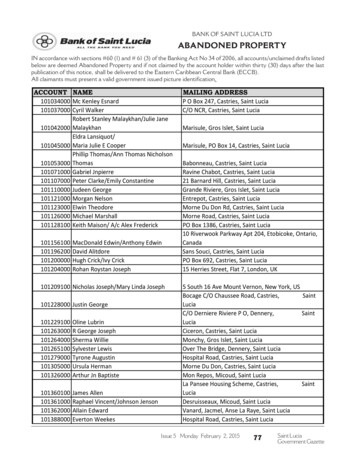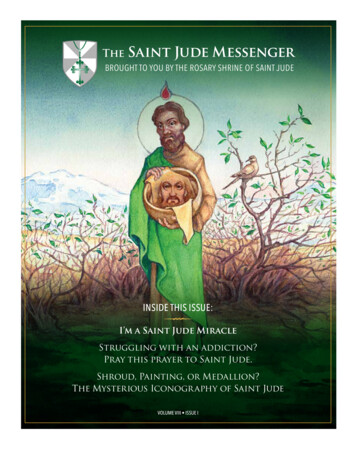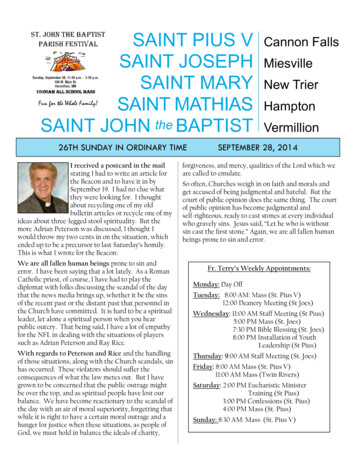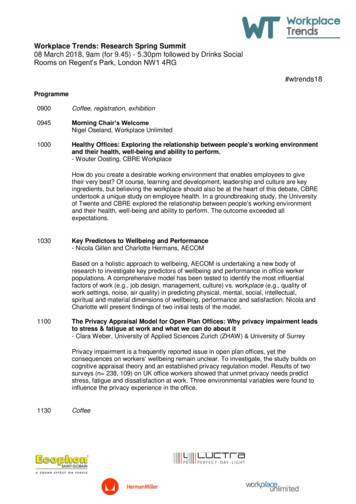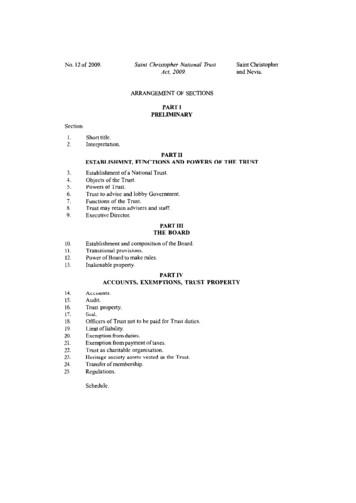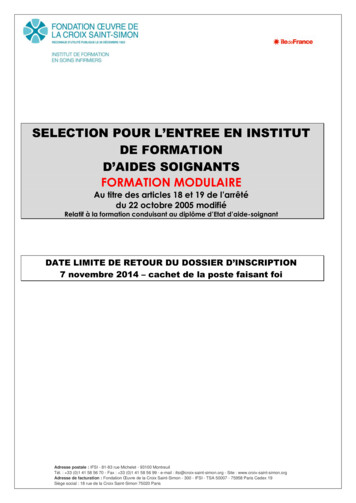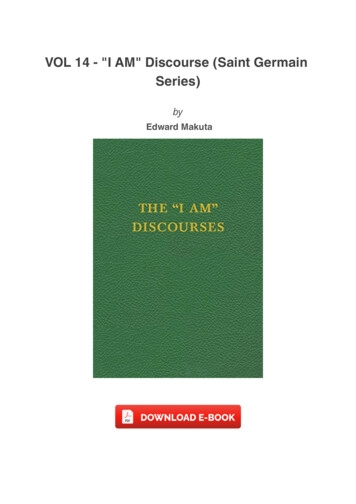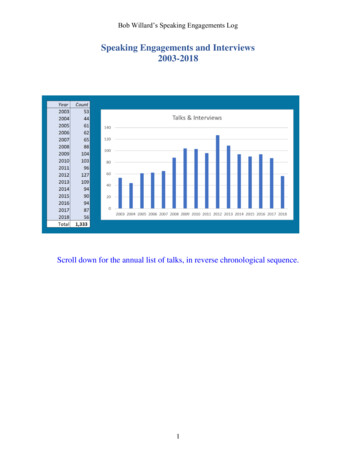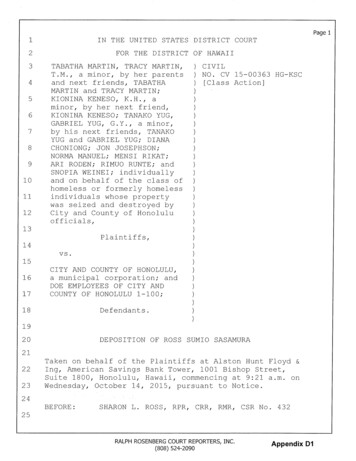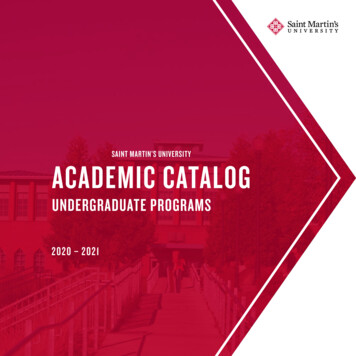
Transcription
SAINT MARTIN’S UNIVERSITYACADEMIC CATALOGUNDERGRADUATE PROGRAMS2020 – 2021
TABLE OFCONTENTS3
TABLE OF CONTENTSMISSION STATEMENT . . . . . . . . . . . . . . . . . . . . . . . . . . . 6HISTORY . . . . . . . . . . . . . . . . . . . . . . . . . . . . . . . . . . . . . 7SAINT MARTIN OF TOURS . . . . . . . . . . . . . . . . . . . . . . . . 8WE ARE THE SAINTS . . . . . . . . . . . . . . . . . . . . . . . . . . . . 10SAINT MARTIN’S AT A GLANCE . . . . . . . . . . . . . . . . . . . . 12STUDENT LEARNING OUTCOMES . . . . . . . . . . . . . . . . . . 14HOW TO APPLY. . . . . . . . . . . . . . . . . . . . . . . . . . . . . . . . . 16First year applicants . . . . . . . . . . . . . . . . . . . . . . . 16Transfer applicants . . . . . . . . . . . . . . . . . . . . . . . . 16International applicants . . . . . . . . . . . . . . . . . . . . 17Schedule a visit to campus. . . . . . . . . . . . . . . . . . 17UNDERGRADUATE PROGRAMS. . . . . . . . . . . 192020-21 Degree Conferral Dates . . . . . . . . . . . .20Bachelor’s Degrees. . . . . . . . . . . . . . . . . . . . . . . . 20General Requirements forBachelor’s Degrees. . . . . . . . . . . . . . . . . . . . . . . . 20Undergraduate Majors andAreas of Study. . . . . . . . . . . . . . . . . . . . . . . . . . . . . . 21UNDERGRADUATE PROGRAMS . . . . . . . . . . . . . . . . . . . 22Mission . . . . . . . . . . . . . . . . . . . . . . . . . . . . . . . . . . 24Learning Outcomes. . . . . . . . . . . . . . . . . . . . . . . .24CORE PROGRAM . . . . . . . . . . . . . . . . . . . . . . . . . . . . . . 24COLLEGE OF ARTS AND SCIENCES . . . . . . . 31BIOLOGY . . . . . . . . . . . . . . . . . . . . . . . . . . . . . . . . . . . .CHEMISTRY. . . . . . . . . . . . . . . . . . . . . . . . . . . . . . . . . .COMMUNICATION STUDIES. . . . . . . . . . . . . . . . . . . . . .CRIMINOLOGY AND CRIMINAL JUSTICE . . . . . . . . . . . .ENGLISH . . . . . . . . . . . . . . . . . . . . . . . . . . . . . . . . . . . .ENVIRONMENTAL STUDIES . . . . . . . . . . . . . . . . . . . . . .EXERCISE SCIENCE . . . . . . . . . . . . . . . . . . . . . . . . . . . .GENDER AND IDENTITY STUDIES . . . . . . . . . . . . . . . . .HISTORY . . . . . . . . . . . . . . . . . . . . . . . . . . . . . . . . . . . .INTERDISCIPLINARY STUDIES. . . . . . . . . . . . . . . . . . . .4SAI NT MA RTI N’S UN IVERS IT Y34404448505458626466LEGAL STUDIES. . . . . . . . . . . . . . . . . . . . . . . . . . . . . . . 68MATHEMATICS. . . . . . . . . . . . . . . . . . . . . . . . . . . . . . . . 70MUSIC . . . . . . . . . . . . . . . . . . . . . . . . . . . . . . . . . . . . . . 74NURSING . . . . . . . . . . . . . . . . . . . . . . . . . . . . . . . . . . . . 80PHILOSOPHY . . . . . . . . . . . . . . . . . . . . . . . . . . . . . . . . . 90PHYSICS . . . . . . . . . . . . . . . . . . . . . . . . . . . . . . . . . . . . 92POLITICAL SCIENCE. . . . . . . . . . . . . . . . . . . . . . . . . . . . 94PSYCHOLOGY . . . . . . . . . . . . . . . . . . . . . . . . . . . . . . . . .98RELIGIOUS STUDIES . . . . . . . . . . . . . . . . . . . . . . . . . . . 102SOCIAL JUSTICE . . . . . . . . . . . . . . . . . . . . . . . . . . . . . . 104SOCIAL WORK . . . . . . . . . . . . . . . . . . . . . . . . . . . . . . . 106SOCIOLOGY AND CULTURALANTHROPOLOGY . . . . . . . . . . . . . . . . . . . . . . . . . . . . . . 110THEATRE ARTS. . . . . . . . . . . . . . . . . . . . . . . . . . . . . . . . 112WORLD LANGUAGES. . . . . . . . . . . . . . . . . . . . . . . . . . . . 114SCHOOL OF BUSINESS . . . . . . . . . . . . . . . .119SCHOOL OF BUSINESS . . . . . . . . . . . . . . . . . . . . . . . . . 120ACCOUNTING . . . . . . . . . . . . . . . . . . . . . . . . . . . . . . . . 122BUSINESS ADMINISTRATION . . . . . . . . . . . . . . . . . . . . 126ECONOMICS . . . . . . . . . . . . . . . . . . . . . . . . . . . . . . . . . 130COLLEGE OF EDUCATIONAND COUNSELING . . . . . . . . . . . . . . . . . . . 133EDUCATIONAL STUDIES . . . . . . . . . . . . . . . . . . . . . . . . 140CERTIFICATION PROGRAMS. . . . . . . . . . . . . . . . . . . . . 144ELEMENTARY EDUCATIONGRADES P–8 . . . . . . . . . . . . . . . . . . . . . . . . . . . . . . . . 150SECONDARY EDUCATIONGRADES 4–12. . . . . . . . . . . . . . . . . . . . . . . . . . . . . . . . 152SPECIAL EDUCATIONGRADES P-12 . . . . . . . . . . . . . . . . . . . . . . . . . . . . . . . . . 156PHYSICAL EDUCATION . . . . . . . . . . . . . . . . . . . . . . . . 160HAL AND INGE MARCUSSCHOOL OF ENGINEERING . . . . . . . . . . . . 163CIVIL ENGINEERING. . . . . . . . . . . . . . . . . . . . . . . . . . . 168COMPUTER SCIENCE. . . . . . . . . . . . . . . . . . . . . . . . . . . 172ELECTRICAL ENGINEERING . . . . . . . . . . . . . . . . . . . . . . 178MECHANICAL ENGINEERING . . . . . . . . . . . . . . . . . . . . 180ENGLISH AS A SECOND LANGUAGE (ESL) . . . 187COURSE DESCRIPTIONS . . . . . . . . . . . . . . 191POLICIES AND PROCEDURES . . . . . . . . . . 287ACADEMIC POLICIES AND PROCEDURES. . . . . . . . . . . 288ADMISSION . . . . . . . . . . . . . . . . . . . . . . . . . . . . . . . . . . 312STUDENT FINANCIAL SERVICES . . . . . . . . . . . . . . . . . 328STUDENT SUPPORT OFFICES . . . . . . . . . . . . . . . . . . . . 340ATHLETIC AND RECREATIONAL PROGRAMS . . . . . . . . . 348CAMPUS DINING SERVICES . . . . . . . . . . . . . . . . . . . . .350EVENT SERVICES . . . . . . . . . . . . . . . . . . . . . . . . . . . . 352RESIDENCE LIFE . . . . . . . . . . . . . . . . . . . . . . . . . . . . . 354STUDENT CONDUCT. . . . . . . . . . . . . . . . . . . . . . . . . . . 356SAINT MARTIN’S UNIVERSITYEQUAL 0PPORTUNITY EMPLOYMENT. . . . . . . . . . . . . . 358CAMPUS FACILITIES . . . . . . . . . . . . . . . . . . . . . . . . . . 360FACULTY AND STAFF . . . . . . . . . . . . . . . . 365DIRECTORY . . . . . . . . . . . . . . . . . . . . . . . . . . . . . . . . . 366TABLE OF C ONTENTS5
HISTORYSaint Martin’s University was established in 1895 by monks of the Roman CatholicOrder of Saint Benedict. The Order, the oldest in Western civilization, was founded bySaint Benedict of Nursia in about 528.From that early time to the present, Benedictines have worked in education. Theirabbey schools nurtured and protected the legacy of the classics of Western civilization.Monk scholars helped write the cultural and educational history of Europe and, in thepast century, that of the United States.MISSION STATEMENTSaint Martin’s University is a Catholic Benedictine institution of highereducation that empowers students to pursue a lifetime of learning andaccomplishment in all arenas of human endeavor.Saint Martin’s students learn to make a positive difference in their own livesand in the lives of others through the interaction of faith, reason and service.The University honors both the sacredness of the individual and thesignificance of community in the ongoing journey of becoming.Benedictine history in the United States began in 1845 when Abbot Boniface Wimmer,O.S.B., established the first American abbey school, Saint Vincent College, near Latrobe,Pennsylvania. From there, Benedictines founded high schools, colleges and universitiesthroughout the country. Saint Martin’s is one of 18 Benedictine colleges and universitiesin the United States and Canada and the only one west of the Rockies.The site of Saint Martin’s University and Abbey, on a wooded hillside in rural Lacey,Washington, was selected in 1893 by Abbot Bernard.Saint Martin’s first enrolled boys and young men between the approximate ages of10 to 20. The new school admitted its first student, Angus McDonald, on Sept. 11, 1895.Both boarders and “day scholars” were accepted and taught from a curriculum ofpreparatory and high school classes, plus classical and commercial college courses.By 1897, 29 students were attending Saint Martin’s. College-level courses were addedin 1900 to provide the necessary education for candidates planning to enter theBenedictine priesthood.Saint Martin’s became a four-year, accredited, baccalaureate-granting institution in1940. The University became coeducational in 1965.Saint Martin’s University also has a long history of building global relationships.In 1920, Father Placidus Houtmeyers was one of the first monks to take Catholiceducation principles to Beijing. Saint Martin’s strong relationships with China andJapan continue today. The University recently celebrated 30 years of collaborationwith Reitaku University recently celebrated 30 years and 25 years old withMukogawa Women’s University.It changed its name from Saint Martin’s College to Saint Martin’s University inAugust 2005 to more clearly define its existing nature and programs, strengthenthe University’s outreach ability and better fulfill its global mission.6SAI NT M A RTI N’S UN IVERS IT YHISTORY7
SAINT MARTIN OF TOURSSaint Martin of Tours, the patron saint of the University, figures prominently in thedevelopment of Christianity in fourth-century Europe. During his lifetime, Martinestablished about 3,500 churches.Although his youth was spent as a cavalryman in the Roman army, he longed forsomething more. He horrified his father, a tribune in the army, by studying to becomea Christian. Legend has it that Martin, while still a soldier, chanced upon a shiveringbeggar clutching his rags about him in the bitter cold. Martin cut his flowing cavalrycloak in two and gave half to warm the beggar. Sometime thereafter, Martin had a visionin which that beggar revealed himself to be the Lord Jesus Christ. Soon after, Martinobtained a discharge from the army.As a free man, he began his commitment to Christianity in earnest, studying underfamous scholars and teachers of the era. Soon he was considered the holiest man inFrance. Although he was sought as a bishop, he chose to remain a missionary until 371,when the people of Tours, France, prevailed upon him to become bishop. Saint Martin’sAbbey and University take their name from this illustrious patron.8SAI NT MA RTI N’S UN IVERS IT YSAINT MARTIN OF TOU RS9
WE ARE THE SAINTSWHY THE HELMET?OUR STORYOUR NEW BRAND USES AS ITSP R I M A R Y S Y M B O L A R O M A N H E L M E T,A N I N T E N T I O N A L C A L L- B A C K T O O U RUNIVERSITY’S NAMESAKE, SAINTMARTIN OF TOURS.Before Saint Martin became a monk, Martin was a Roman soldier, like his father and hisfather’s father before him. Legend has it that Martin chanced upon a shivering beggarin the bitter cold. Martin then drew his sword and cut his cloak in two and gave half towarm the beggar. Later, Martin received a vision in which the beggar revealed himselfto be Jesus Christ. With that vision, Martin was inspired to leave the army and pursuehis faith, becoming a monk, a teacher and eventually a bishop. He continued to live hislife committed to helping others. His actions recall the Benedictine values of hospitality,community living, justice and respect for persons.YOU ARE A SAINT!We hope you, our young women and men, throughout your time here and after,will think of Saint Martin on that path where he encountered another, acted out ofcompassion and in the process transformed his own life.10SAI NT MA RTI N’S UN IVERS IT YWE ARE THE SAINTS11
SAINT MARTIN’SAT A GLANCELACEY, WASHINGTON60 ACADEMIC PROGRAMS40 CAMPUS CLUBS13 DIVISION 11 SPORTS22 MONKS ON CAMPUS11:1 FACULTY TO STUDENTSaint Martin’s University is located in Lacey, Washington, adjacent to Olympia, thestate capital. The population of the Lacey area is about 50,000, and that of ThurstonCounty — which includes the greater Olympia area of Lacey, Olympia and Tumwater —is about 280,000.The beauty of the 300-acre Saint Martin’s campus reflects the rich intellectualand spiritual nature of its presence in the Pacific Northwest. The wooded areas ofcampus are threaded with pleasant walking trails. Many species of wildlife roam theundeveloped acres on campus and in the meadows below the main University buildings.Located near the shores of South Puget Sound, Saint Martin’s is conveniently locatednear Interstate-5, less than an hour from Seattle, two hours from Portland, Oregon, and30 minutes from Tacoma. In nearby cities, students can take advantage of events rangingfrom topflight art shows, concerts and theater, to professional sports. With its proximityto metropolitan areas, the greater Olympia area also attracts nationally recognizedentertainers, artists and musicians, providing cultural opportunities to complement theUniversity’s educational experience.The University’s proximity to the state capital gives students an opportunity towatch and take part in legislative and government-related activities. Valuable studentinternships and work experiences can be obtained through positions in governmentoffices and agencies.For nature lovers, the area is exceptional. Swimming and other water activities are asclose as five minutes from campus on a wealth of nearby lakes, streams and ocean inlets.Pacific Ocean beaches, just 50 miles west, offer opportunities for clamming, kite flying,deep-sea fishing and sailing. Less than an hour away, hikers, skiers, backpackers andother outdoor enthusiasts can pursue their favorite pastimes in the mountains or enjoysuch spectacular Northwest attractions as Mount Rainier National Park, Mount St.Helens, the Olympic Peninsula and the San Juan Islands.12SAI NT MA RTI N’S UN IVERS IT YSAINTSAINT MARTIN’SMARTIN’S ATU NIVERSITA GL ANC YE13
STUDENT LEARNING OUTCOMESIn addition to program-specific learning outcomes, all Saint Martin’s Universitystudents, supported and nurtured by faculty and staff, will aspire to Develop the ability to raise vital questions, gather evidence while suspendingjudgment, and critique and construct compelling arguments. (CRITICAL THINKING SKILLS) Develop values-based convictions and act upon them. Show concern for issues thattranscend their own interests and participate in civic life. (SOCIAL RESPONSIBILITY ANDCIVIC ENGAGEMENT) Cultivate a lifelong engagement in intellectual growth. (Lifelong learning) Listen carefully and thoughtfully and express ideas effectively through writing andspeech. (COMMUNICATION SKILLS) Demonstrate an awareness of diverse perspectives in understanding issues andinteracting with others as well as show an appreciation of diverse cultural valuesand the interconnectedness among cultures. (GLOBAL AND INTERCULTURAL COMPETENCIES) Assess critical needs of a situation and create a vision to address those needs.Motivate and inspire people to engage ith that vision. (LEADERSHIP SKILLS)14SAI NT MA RTI N’S UN IVERS IT YSTU D ENT LEARNING OU TC OMES15
HOW TO APPLYFirst-year studentsApplication requirements for exchange students include:FIRST YEAR APPLICANTS Completed applicationYou are a first-year student if you have never attended college, or have earned collegecredits but only prior to high school graduation (usually through Running Start,College in the High School, etc.). Proof of English language proficiencyApplication requirements for first-year students include: Saint Martin’s Application or the Common Application* Personal essay** Your official and sealed high school transcript‡ A letter of recommendation from a teacher or counselorTRANSFER APPLICANTSHow long have you been out of high school?We recognize some transfer applicants may have been out of high school formany years.As such, our admission counselors will tailor the application and review processto each individual student, requesting only those materials deemed necessary in orderto effectively evaluate each applicant.Making sure your community/technical college credits transfer is an important stepin applying to Saint Martin’s. We have direct transfer agreements with 27 communitycolleges in the state of Washington.Application requirements for transfer students include: Saint Martin’s Application or the Common Application* Personal essay** Official transcripts from all colleges and universities attended Your official SAT/ACT scores, if applicable† Your official high school transcript, GED certificate or home school documentation,if applicable† Military credits‡16INTERNATIONAL APPLICANTSSAI NT MA RTI N’S UN IVERS IT Y Official secondary school transcripts Copy of passportTransfer studentsYou are considered a transfer student if you have completed secondary schooland have attended college or university.Application requirements for transfer students include: Completed Saint Martin’s application Official university transcripts Proof of English language proficiency Copy of passport Transfer eligibility form Copy of current I-20 Copy of current F-1 visaSCHEDULE A VISIT TO CAMPUSAs we celebrate 125 years at Saint Martin’s University, we look forward to welcomingyou and taking you on a guided tour of our beautiful campus. We hope to learn moreabout you and your goals and aspirations as we share all Saint Martin’s has to offer.Prospective undergraduate students automatically qualify for our 500 visit awardfor fall 2020 by participating in a campus tour.Special visit options: Saturday visits Holiday visits Overnight visitsSchedule your visit today at www.stmartin.edu/visitHOW TO APPLY17
UNDERGRADUATEPROGRAMS18SAI NT MA RTI N’S UN IVERS IT Y19
UNDERGRADUATE PROGRAMSSaint Martin’s University prepares students for successful lives. Our undergraduatemajors span the liberal arts and science, business, education and engineering. SaintMartin’s University prides itself in smaller class sizes, a wide array of opportunitiesto conduct research projects, participate in practicums, cultural activities,internships, and study abroad programs.UNDERGRADUATE MAJORS AND AREAS OF STUDYUndergraduate opportunities for major, minors, course work, areas for Washington State teaching certification, and academiccertificates are indicated in the table below:AREAS OF STUDYAccountingMAJORSMINORS Art2020-21 DEGREE CONFERRAL DATESFall 2020. . . . . . . . . . . . . December 19, 2020Spring 2021 . . . . . . . . . . May 08, 2021Summer 2021 . . . . . . . . August 21, 2021The full academic calendar can be found at emic-calendarBACHELOR’S DEGREESThe University confers the following bachelor’s degrees: Bachelor of Arts,Bachelor of Science, Bachelor of Science in Civil or Mechanical Engineering,Bachelor of Science in Nursing, and Bachelor of Science in Social Work. In mostcases, these degree programs can be completed within eight academic semesters.Biology Business Administration (Concentrationsin Accounting, Data Analytics, Economics,Finance, International Business,Management and Marketing) Chemistry Chinese Communication Studies Computer Science Criminology and Criminal Justice Economics Educational Studies Elementary Education Exercise Science English Language Learners French Geography Gender and Identity Studies Global Studies Humanities (middle level cert.) Environmental Studies Support and/or elective courses necessary to meet the 120 semestercredits unit requirement. Civil EngineeringHistoryCERTIFICATE Students must successfully complete a minimum of 120 credit hours with acumulative Saint Martin’s University grade point average (GPA) of at least2.00, in addition to the following: All University core requirements (please see the next catalog section) Bilingual EducationElectrical Engineering A major sequence with a minimum of 20 upper division credit hours andcumulative grade point average of 2.00 in all upper division courses for the major.WASHINGTONTEACHINGCERTIFICATE GENERAL REQUIREMENTS FOR BACHELOR’S DEGREES 40 semester credits of upper-division coursework.COURSES ONLY Note: some departments require more than 120 semester hours to complete the bachelor’s degree.Students should consult with their departments to determine the minimum number required fortheir major.20SAI NT MA RTI N’S UN IVERS IT YU ND ERGRAD UATE PROGRAMS21
UNDERGRADUATE PROGRAMSAREAS OF STUDYInformation TechnologyInterdisciplinary StudiesJapanese StudiesLegal StudiesLiterary StudiesMathematicsMechanical EngineeringMusicNursingPhilosophyPhysical Education (health/fitness cert.)PhysicsPolitical SciencePsychologyReadingReligious StudiesRN to BSN Nursing ProgramRussianScience (middle level cert.)Secondary EducationSocial JusticeSocial StudiesSocial Work (Concentrations in SubstanceUse Disorder and Trauma Studies)Sociology and Cultural AnthropologySpanishSpecial EducationSpeechSubstance Use DisorderTheatre ArtsWriting22SAI NT MA RTI N’S UN IVERS IT YMAJORSMINORSCOURSES ONLYWASHINGTONTEACHINGCERTIFICATE CERTIFICATEAREAS OF STUDYMAJORSMINORSCOURSES ofessional PreparationDentistry Law Medicine Nursing Optometry Pharmacy Physical Therapy Veterinary Medicine U ND ERGRAD UATE PROGRAMS23
CORE PROGRAMMISSIONCORE CURRICULUMThe Core Program consists of classes which ensure deep engagement bystudents and faculty in subjects which collectively constitute the heart of thelearning experience at Saint Martin’s University. The Core consists of ninetwelve courses plus the Capstone; roughly half the Core is offered in 4-credits,while the rest consists of 3-credit courses.The Core Curriculum consists of three distinct phases: Foundations, offeredat the 100-level, intended to transition incoming students into the university;Conversatio Seminars, offered at the 200-level, designed to place disciplinesin conversation with one another in the hopes of transforming studentunderstanding of a particular question, problem, or issue; and Ora et LaboraSeminars, offered at the 300-level, fashioned to transition from ora (mindfullistening, reading and learning) to labora (work in the world).The Core Program, developed by faculty from across disciplines and colleges/schools, translates the Catholic intellectual tradition and Benedictinefoundations of the University into a set of academic values and practices thatare fully consonant with the AAUP statement on academic freedom.LEARNING OUTCOMESCritical Thinking: Students will be able to raise vital questions, gather evidencewhile suspending judgment, and construct compelling arguments.Lifelong Learning: Students will be able to demonstrate the skills anddispositions, such as curiosity, initiative, independence, transfer and reflection,that enable a lifelong engagement in intellectual growth.Communication Skills: Students will be able to listen carefully and thoughtfully,and to express ideas effectively, through writing and speech.Social Responsibility and Civic Engagement: Students will demonstrate theability to develop, articulate, and act upon ethical convictions, specifically inregard to social justice concerns. Students will demonstrate the knowledge,skills, values and motivation to make a difference in the civil life of acommunity.Global Learning and Intercultural Competence: Students will value globalcommunities and practice/demonstrate empathetic sensitivity and awarenessof diversity (e.g., ethnic, economic, religious, gender).Foundations requirements:All traditional first time first year students entering the university, includingthose with Running Start, AP and/or International Baccalaureate credits, arerequired to take CORE 100. Transfer students entering the university withfewer than 20 semester credits are also required to take CORE 100. COR110 andCOR340W are not fulfilled with AA-DTA degree and are required of all transferstudents. Transfer students without a DTA Associate’s degree or Bachelor’sdegree may be required to take additional CORE courses, depending on acourse-by-course evaluation of their transfer coursework.Students who take a Math course numbered from 121 through 201 will havesatisfied the requirement for CORE 130. Students seeking a B.A. whose major orminor does not require a World Language and who do not place into a 201-levellanguage course or higher are required to take CORE 140.Conversatio requirements:Students are required to take one of each type of seminar; at least one of thefive seminars taken at the 200-level must be writing intensive. It is highlyrecommended that students have taken COR120 or the equivalent beforeregistering for a writing-intensive course.Ora et Labora requirements:Students are required to take two different seminars; at least one of thetwo seminars taken at the 300-level must be writing intensive. It is highlyrecommended that students have taken COR120 or the equivalent beforeregistering for a writing-intensive course.24SAI NT MA RTI N’S UN IVERS IT YC ORE PROGRAM25
CORE PROGRAMCOR100First-year Seminar (4)A seminar that introduces students to the foundational values and practicesof Catholic Benedictine education, and helps them navigate the culture ofacademic life by establishing a foundation of academic expectations, skills, andpractices required for success at the university.COR110Religious Studies (3)A foundational course that introduces students to the academic study ofreligion, with a focus on traditional and emerging beliefs and practices thatshape individuals and communities both locally and globally.COR120Critical Reading and Writing (4)A seminar designed to develop foundational skills in critical reading, thinkingand writing. Includes reading of and writing in a variety of rhetorics, with aspecial focus on the argumentative essay.COR130Quantitative Reasoning or Applied Mathematics (3)A foundational course in quantitative reasoning and mathematics, with aspecial focus on applying such reasoning to practical problems.COR140*World Languages and Cultures (4)A foundational course in the study of a World Language that helps preparestudents to be global citizens by providing real-world language acquisitionexperiences that enable them to become proficient in the areas of speaking, oralcomprehension, reading, and writing.COR140C — ChineseCOR140F — FrenchCOR140J — JapaneseCOR140R — RussianCOR140S — Spanish26SAI NT MA RTI N’S UN IVERS IT YCOR210*Humanities (3)COR210*WHumanities — Writing Intensive (4)An interdisciplinary seminar that considers important questions, problemsor issues arising in the Humanities, with a view to introducing students tohumanistic modes of inquiry.COR210D — World LanguagesCOR210P — PhilosophyCOR210R — Religious StudiesCOR210Y — Literary StudiesCOR220*Social Sciences (3)COR220*WSocial Sciences — Writing Intensive (4)An interdisciplinary seminar that considers important questions, problemsor issues arising in the Social Sciences, with a view to introducing students tosocio-scientific modes of inquiry.COR220C — Communication StudiesCOR220E — EconomicsCOR220G — Gender & Identity StudiesCOR220L — World PoliticsCOR220J — Criminal JusticeCOR220P — PsychologyCOR220S — Society and Social JusticeCOR230*Natural Sciences with Laboratory (4)An interdisciplinary course with a laboratory that considers importantquestions, problems or issues arising in the Natural Sciences, with a view tointroducing students to various scientific modes of inquiry.COR230B — Biology w/ LabCOR230C — Chemistry w/ LabCOR230E — Environmental Science w/ LabCOR230P — Physics/Astronomy w/ LabC ORE PROGRAM27
COR240*Artistic and Creative Expression (3)COR240*WArtistic and Creative Expression – Writing Intensive (4)A seminar that introduces students to the importance of the arts and artisticexpression. May include a creative and/or self-expressive component.COR240A — Artistic StudiesCOR240M — Musical StudiesCOR240T — Theatrical StudiesCOR250*Historical and Political Studies (3)COR250*WHistorical and Political Studies – Writing Intensive (4)A course that considers the origins and development of the United States as acivilization and a nation, with a view to introducing students to historical andpolitical modes of inquiry.COR250P — United States PoliticsCOR250U — US HistoryCOR310COR310 WCommunity: The Call to Serve the Common Good (3)Community: The Call to Serve the CommonGood — Writing Intensive (4)Throughout its long history, the Benedictine monastic tradition has maintainedan abiding commitment to community. This commitment involves cultivating aprofound awareness of being rooted in and responsible to a particular place, aswell as an ethic of mutual labor and service. This practical focus on communitybuilding finds its expression at Saint Martin’s in an attempt to forge connectionsbetween the individual and the communal, the local and the global, the past,present and future. This interdisciplinary seminar explores issues confrontingglobal communities and situates them in their social, cultural,and/or historical context.COR330COR330 WStewardship: Responsible Use of Creation (3)Stewardship: Responsible Use of Creation — WritingIntensive (4)The Rule of Saint Benedict expresses reverence toward God’s creation anddemands
Saint Martin's became a four-year, accredited, baccalaureate-granting institution in 1940. The University became coeducational in 1965. Saint Martin's University also has a long history of building global relationships. In 1920, Father Placidus Houtmeyers was one of the first monks to take Catholic
